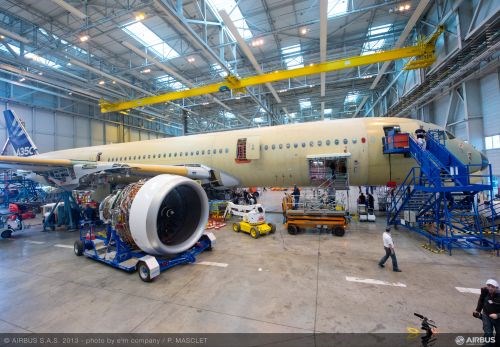Boeing, Airbus neck and neck at end of 2013
Both planemakers set records for orders, deliveries and backlogs in 2013, as the year just ended looks to be one of the healthiest for the commercial aerospace industry in more than 10 years.

After some recession-induced lean years in aerospace manufacturing, 2013 data signals a return to order and delivery rates not seen in almost ten years.
For those who miss the bipolarity of the Cold War, rest assured that there remains a corner of the world in which two (corporate) giants still slug it out year after year, pushing each other in a competitive battle that shows no signs of abating.
Thus, with 2013 fading into history, Boeing (Seattle, Wash., USA) and Airbus (Toulouse, France) have reported their orders, deliveries and backlogs as of Dec. 31. If it's hard to declare a "winner," each planemaker can at least rest comfortably in the knowledge that 2013 was a good, record-setting year for each company.
In short, 2013 looked like this for the two firms (all figures are aircraft units):
| Planemaker | Orders | Deliveries | Backlog |
| Boeing | 1,531 | 648 | 5,080 |
| Airbus | 1,619 | 626 | 5,559 |
One of the very attractive aspects of making large commercial airplanes is the fact that accumulating a large backlog is not only acceptable, but in some ways beneficial. A large backlog communicates to the planemaker's supply chain just how much work (and revenue) they can count on, and it signals to the broader aerospace market just how healthy the industry is. And by any measure, the commercial aerospace industry is pretty healthy. A backlog of 5,000+ units guarantees about eight years of work and revenue and profits. On top of that, the rapid pace of manucturing and assembly of deliverable aircraft shows a level of efficiency not seen in the aerospace industry in many years.
This is true not just of Airbus and Boeing, but of all commercial aircraft manufacturers, who taken together will likely make 2013 one of the healthiest years in more than a decade.
What will be interesting is to see how the landscape changes in the coming years. Right now, there are only four commercial aircraft manufacturers: Airbus, Boeing, Bombardier and Embraer. With China's COMAC working on the C919 jet, and with Irkut working on the MS-21 jet (both single aisles), this space is likely to be more crowded, and competitive, soon.
Related Content
-
Plant tour: Albany Engineered Composites, Rochester, N.H., U.S.
Efficient, high-quality, well-controlled composites manufacturing at volume is the mantra for this 3D weaving specialist.
-
Plant tour: Joby Aviation, Marina, Calif., U.S.
As the advanced air mobility market begins to take shape, market leader Joby Aviation works to industrialize composites manufacturing for its first-generation, composites-intensive, all-electric air taxi.
-
Plant tour: Middle River Aerostructure Systems, Baltimore, Md., U.S.
The historic Martin Aircraft factory is advancing digitized automation for more sustainable production of composite aerostructures.
















